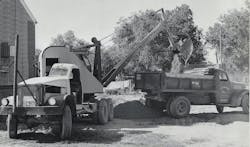Little Giant Crane & Shovel
As hydraulic excavators gained industry acceptance in the late 1950s and early 1960s, the market for the small cable-operated excavators that had been produced by the thousands since the 1920s rapidly dwindled to almost nothing. Little Giant Crane & Shovel of Des Moines, Iowa, was not only one of the minor players in that market, but it was also one of the last to offer these machines.
Company founder John Lewis Grundon’s father and grandfather had each designed and built an excavator, and Lewis, as he was known, was an oiler on his father’s machines as a teenager. He learned to operate excavators and began formulating his own ideas for improving them.
His biggest idea was substituting simple ball bearings for the bulky, troublesome, and maintenance-intensive hook, roller, and center pin assemblies upon which the upper works rotated. He built his first machine with this design in 1946, and was awarded a patent for the design in 1949. The smooth swing was Little Giant’s advertising hallmark, and on expiration of the patents the design came into wide use across the industry. Grundon also innovated self-aligning ball bearings and ease of maintenance access for the main drums, and anti-friction bearings for all main shafts.
The first production model was the 1/2-yard-capacity Model S, for mounting on commercial trucks. The 1/3-yard Model L (shown at top) followed in 1951—it was offered on a carrier designed by Little Giant—and the CL crawler mounting was Little Giant’s first crawler machine. Fifteen more models on trucks, standard, or Swamper super-wide flotation crawlers, self-propelled chassis, or railroad wheels, were introduced in the 1950s. The largest was rated at 5/8 yards. Introduced in the late 1980s, the 3/4-yard C48H and 1-yard C64H may have been the last models of small cable excavators introduced in the American market.
While continuing production of cable machines, Little Giant went along with the rest of the excavator industry in developing hydraulic machines. Its first such machines were hybrids with fully hydraulic booms and buckets, but mechanical swing clutches and lower works. The 1-yard Combo-K was the largest of this line, and one of Little Giant’s largest machines of any kind. The slightly smaller Combo-J was one of the first hydraulic excavators that could be converted to cable use, as a dragline. The hydraulic excavators were limited by poor working pressure and were discontinued by the late 1960s. Little Giant also began developing hydraulic cranes, starting with a boom attachment for the Combo-12 excavator, and a line of cranes rated up to 15 tons continued into the 1990s. A telescopic excavator was introduced to good results in 1972.
Over the years, the Little Giant name became synonymous with the railroad industry. The little machines, perfect for working from a flatcar, were subsequently fitted with hi-railer kits and put to work right on the rails, and maintenance-of-way work was the machine’s forte.
Today, Little Giant Corp. continues to produce cranes for the construction and railroad industries as a division of Manitex International.
The Historical Construction Equipment Association (HCEA) is a 501(c)3 nonprofit organization dedicated to preserving the history of the construction, dredging and surface mining equipment industries. With over 3,800 members in 25 countries, activities include publication of a quarterly educational magazine, Equipment Echoes, from which this article is adapted; operation of National Construction Equipment Museum and archives in Bowling Green, Ohio; and hosting an annual working exhibition of restored construction equipment. The next International Convention and Old Equipment Exhibition will be September 23-25, 2022(Note date change) at the National Construction Equipment Museum in Bowling Green, Ohio. Individual annual memberships are $30 within the U.S. and Canada, and $55 U.S. elsewhere. HCEA seeks to develop relationships in the equipment manufacturing industry, and offers a college scholarship for engineering and construction management students. Information is available at www.hcea.net, or by calling 419.352.5616 or e-mailing [email protected].
